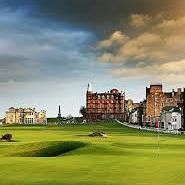I recently read a short posting by an excellent golf blogger, Charles Prokop. A link is below. I highly recommend his blog for short, well-written essays on golf and life in the Texas Hill Country.
http://fairwaywords.com/2015/11/06/patience-in-golf-really-does-pay/
His tongue-in-cheek conclusion about the virtues of being patient got me thinking. I have played golf in SE Michigan for 40 years. Over those four decades I have played around, over and through a number of trees that I have silently and not so silently wished would have a close encounter with lightning or a chain saw. A contest of patience with a tree is rarely rewarded but given enough time, one just might win a few. ![]()
Hole #1 – Huron Meadows: When I began playing this course, the short par 5 (483 yards) had a fully mature oak tree smack in the middle of the fairway, between two water hazards. If one had plenty of distance or talent, getting past or around this obstacle wasn’t impossible. For rest of us who hit less than 280 yards and had some concerns with working the ball, the tree was a considerable obstacle.
One spring day I got ready to tee off and noted something seemed different. The tree was gone! It had been replaced by a thin “aerial antenna” newly planted tree. It turned out during the winter a storm had toppled the massive tree and all they could do was plant a replacement and wait 100 years. The course wisely planted the tree somewhat off center to one day reward a ball in the center of the fairway.
Hole #12 – Lake Forest: This par 4 (364-328 yards) was universally disliked. The tee shot required one to hit a layup about 180-220 yards, depending on the tee. The fairway ended at the 150 yard marker. Anything that went much beyond the 150 yard marker would roll downhill into a water hazard. If the ball hung up in the rough, then one had a downhill lie and, depending on the time of year, a wall of 10 foot tall cattails & reeds to hit over.
The problem with the layup was a grouping of 3 mature Beech trees which sat in the middle of the hole just beyond the 150 yard mark. Lay up to the 150 yard marker in the middle and one was completely blocked. Going toward the left rough required threading a shot along the forest to the left of the fairway. The only solution was to hit well right into the rough, leaving a longer shot to the dogleg left green.
One spring the trees had vanished. A rumor making the rounds was that a regular at the course had taken a chainsaw to the trees while the club was closed for the winter. I suspect the rumor was just a flight of fancy and that the owners of the club had decided the trees had to go. Whatever the truth is, the hole plays much better now.
I don’t want everyone to think I am anti-tree. Far from it, I believe our parkland courses need strategically placed trees & forest. There are many holes that have been sadly diminished by the loss of one or more trees. If takes so long for replacement trees to grow that the course is pretty much altered for the balance of one’s lifetime when a tree is lost. Of course, if that oak on Eagle Crest’s 11th hole should somehow get struck by lightning, I won’t shed many tears for it.
Anyone have some tree stories to share?
-
 1
1








28 Comments
Recommended Comments
Create an account or sign in to comment
You need to be a member in order to leave a comment
Create an account
Sign up for a new account in our community. It's easy!
Register a new accountSign in
Already have an account? Sign in here.
Sign In Now